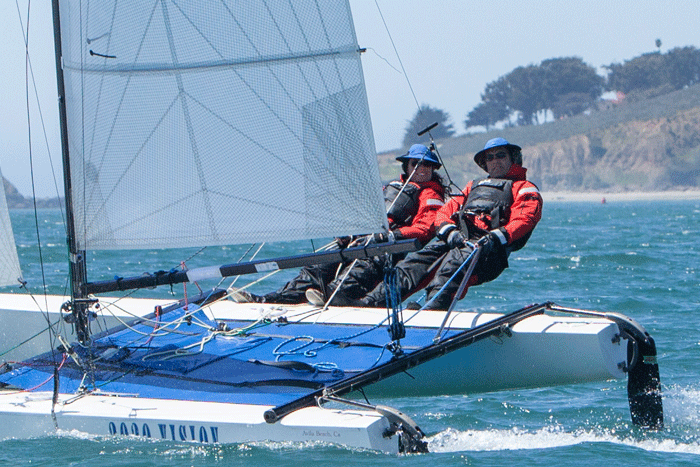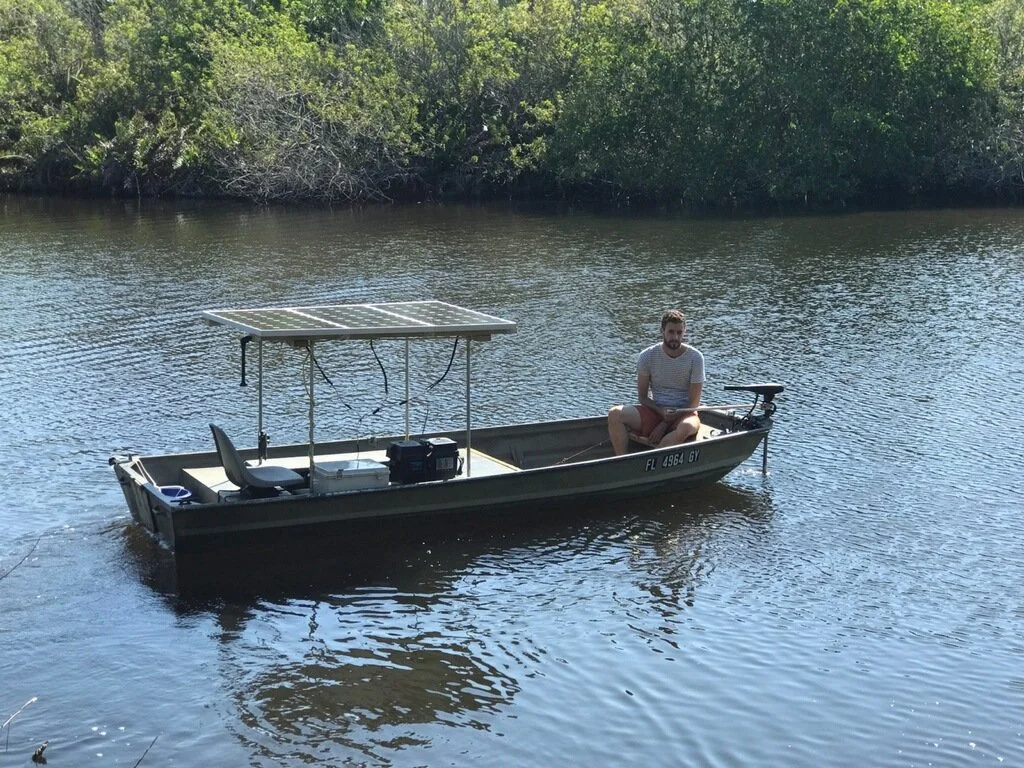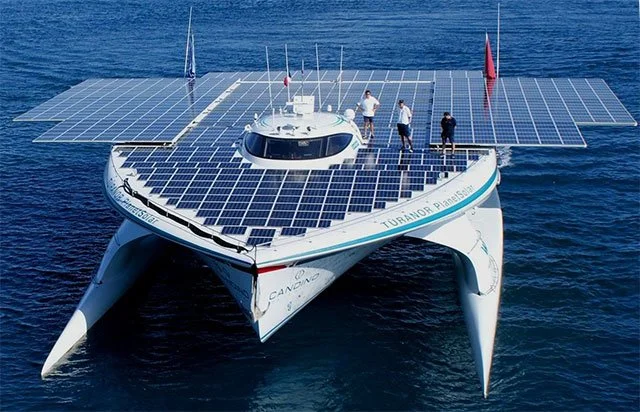Solar Sail Advenurecraft
Overview
Solar powered boats are a fancy toy for the mega-rich, right? Not necessarily. What if solar-powered craft could be cheap and simple enough to rent out to the general public?
Solar power and electric propulsion have both become fairly affordable as long as you keep your expectations reasonable and your battery small. Envision a catamaran roughly the size of the Hobie Cat pictured to the right. Remove the sail and mast, but keep the trampoline between the hulls. Above the tarp, imagine a solar pagoda: A canopy of solar panels supported by four corner posts. Between two or more of these corner posts are lounging canvas bench seats or hammocks or similar. The whole thing resembles a mini pontoon boat with capacity for about 4 people.
What’s a reasonable power expectation for such a vessel? It helps to make the comparison to a human-powered craft, a typical human working moderately hard over the course of an hour could be expected to produce about 200W of steady-state power output. Over the course of 8 hours in steady state it’s more like 100W of effort per person. So a craft with let’s say 2x 600W thrusters intended for RC boats would be able to put down as much power as six men rowing. That’s still less power than you’d get from a gasoline outboard motor. (even the small outboards put out about 2000W) but would still be very impactful on a lightweight vessel with an efficient hull design such as a sailing catamaran or a kayak.
So what does it take to power 1.2kw of electric thrust directly from the solar? Well, you’d want maybe 40% more nameplate solar power than you actually consume in steady state. That’s not a problem because solar is cheap and doubles as shade. While grid-scale panels are used by a lot of DIYers for solar canopies, they really aren’t the most appropriate choice for a moving vehicle due to the large distance spanned by a single pane of glass. If we keep to the smaller, narrower glass panels intended for mobile use, a good representative choice is the Newpowa 210W 12v monocrystaline panel. A canopy of 8 of these panels would give us the 40% overhead required and would shade an area of 9ft x 11ft at a cost (retail) of about $1800, not including mounting. This would make the canopy just about the right size for the roof of a pagoda on a catamaran. Combine this with a fairly low power MPPT controller and a small-ish lithium battery and the entire propulsive power system from panels to propeller is in the range of $3-4000.
While to some, the idea of a $3000 electric propulsion system that can’t match the power of a small gasoline outboard may sound ludicrous, it should be very appealing to anyone in search of quiet low-maintenance craft for extended use where speed is not necessarily a concern. While this concept will be appealing to some for fishing or general transportation, I think the real killer applications are boat tours, individualized explorations of water-accessible parklands, and sea-backpacking style adventuring.
A big part of making this business a success would be very close partnership with one or more tourist attraction rental sites. And a big part of being rental friendly is the optional inclusion of remote monitoring and override of the craft. It’s not nearly as expensive as it all sounds. An all-electric craft powered by RC boat motors is just a short step away from being an RC toy as it is. Providing radio telemetry, communications, and overrides at a low cost to fleet managers can help us to lock down the large institutional orders early on as well as to position our boats in places to gain exposure to other potential customers.
For this type of rental or institutional use, it would be best to target locations such as lakes near blue cities, sunny vacation spots with sounds or similar protected waters, and any particularly trendy or progressive location along a scenic river or canal well suited to these boats.
There’s also the matter of setting customer expectations appropriately. Our marketing needs to emphasize that these are solar sail boats and that your speed is determined by how quickly the sun can push you along. The batteries (in the base model at least) only function as a power reserve so that you can slowly steam home on a cloudy day. Drag increases exponentially with speed, so by limiting the battery-only speed of maybe 1/3 the top full-sun cruising speed, you can get a lot of reserve range out of a small battery. It also adds to the novelty of the experience for casual users when their best speed is set by the elements in a way that is reflective of the experience of sailing, but with a much lower skill requirement. Of course, for some customers this lack of ability to cruise at top speed on battery will be a major frustration. For them, we can always offer larger battery systems as an option along with the ability to draw power from those batteries at a higher rate. Want twice the thrust? We can have that as an option too. While our base model is intended to be very accessible, there’s no good reason we can’t make the design modular so that it can be optioned-up for anyone willing to pay.
So what’s the cost on the base model? Well, Hobie retails the Hobie Cat 16 at an MSRP of about $13k, which we can use as a starting point of price estimations. Presumably they’re turning a healthy enough profit on their boats to sustain business. We’ll eliminate the costs of sails and rigging, but that will likely be offset by the frame of the solar pagoda and the seating. Add maybe $5k to that for our $3-4k electric propulsion system and some additional profit/overhead and that brings us to a direct-to consumer price of roughly $18k for an affordable electric adventure boat with unlimited range. Note that this is probably on the high side as it’s before any attempts to cost-reduce the hull design. There’s also a lot of wiggle room depending on what profit margins Hobie sees on their boats and where we would want to set ours. This is also assuming a fairly one-size-fits-all boat. For some applications, a miniaturized version similar in size to a paddle boat could be offered using even less power and cheaper components. This miniaturized version could conceivably retail below $10k.
A Hobie Cat, a common sailing catamaran with one hull being “flown” out of the water.
Kit De-Scope or Offshoot
Another possible way to take advantage of the insight of cheap low-power electric propulsion is to develop and offer retrofit kits to existing boats. This could include personal craft such as kayaks but also larger small craft such as john boats, small sailing boats, and sailing catamarans. These kits could be fairly modular and versatile and allow for the end-users to source pre-owned boats, panels, and batteries if desired while we continue to profit from the hardware that connects it all to the boat and makes it function.
While this may ingratiate us with the DIY crowd, it’s much less likely to attract the type of institutional customer that can serve as free promotion and it also muddies the waters when it comes to any applicable governmental green incentives which may end up playing a significant role in our value proposition. For those reasons, I think the DIY-type applications need to be secondary to creating one or two highly polished, but cost-considerate products.
One of several DIY solar boat projects that can be found online. This is Brian’s 300W boat.
The Planet Solar: the big expensive version of what I’m proposing



